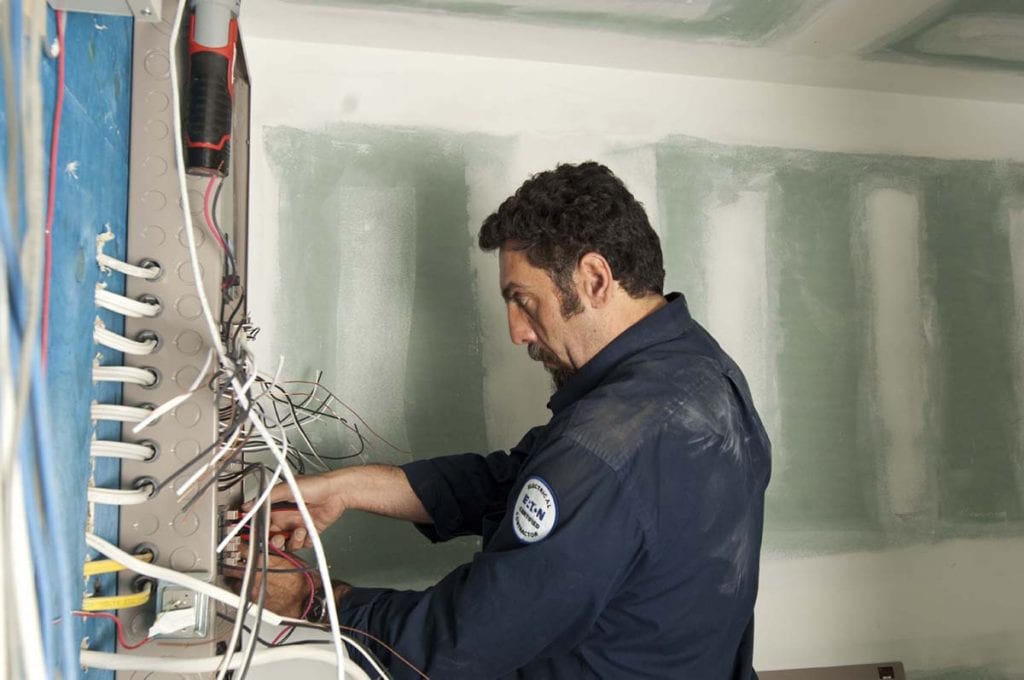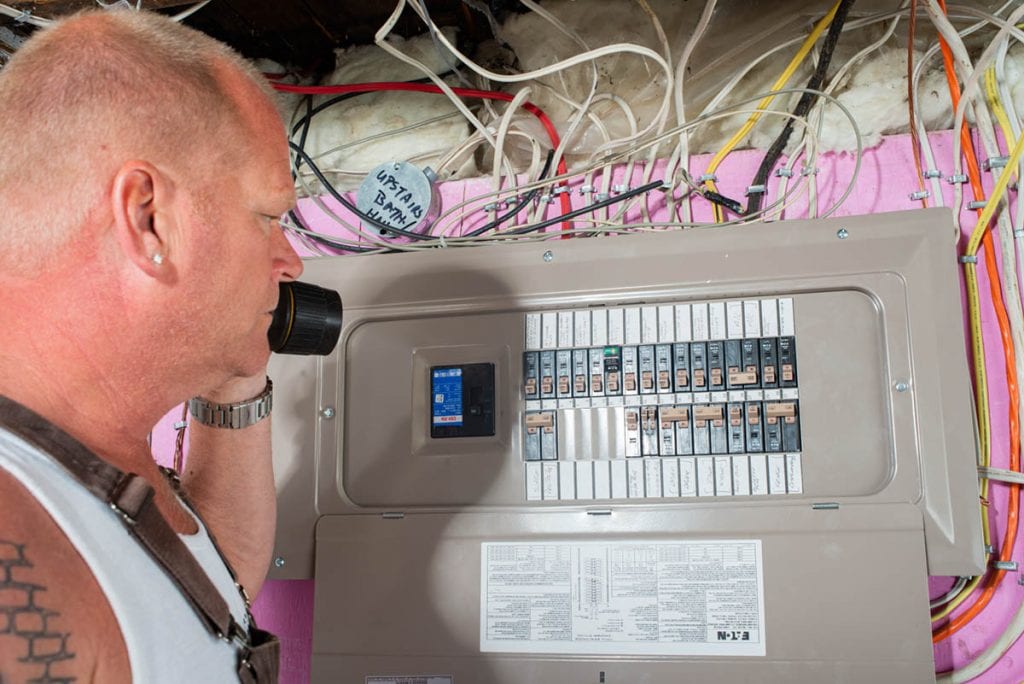If you’ve watched me over the years, you know I’m big on one thing: doing it right. That doesn’t just apply to how you build or renovate a home...

How To Install An EV Charging Station At Home
By Mike Holmes
Mike’s Advice / Electrical
Wednesday, January 19th, 2022 @ 8:42am
What Do You Need To Know About EV Charging Stations?
Electric Vehicles or EVs are the way of the future. Major automobile companies are manufacturing EVs that are powered partially or fully by electric power, in all shapes, sizes and models. They are more affordable to drive and require less maintenance than regular gas-fuelled cars which is great. However, proper preparation is vital for avoiding difficulties, problems, and money later on.
So, before you go any further, keep the following points in mind:
- Understand how EV Charging works and what’s required.
- Choose when and where you want to charge your electric vehicle.
- Examine your utility capacity.
- Select your charging system
Here is a guide on what you should know about EV Charging Stations and getting one installed in your home.
What Are EV Charging Station Requirements?
I’m a contractor who happens to like cars and trucks. While I don’t have an EV right now, I might consider one in the future as they are becoming increasingly popular. According to an estimate, more than half the cars sold in Canada will be electric by 2030. So it makes sense to understand EVs electrical needs.
What Is The Best Location For Installing EV Charging Stations At Home?
If you are thinking of getting an EV, you need to consider where you’ll charge your car. If you live in a condo building you may find that your building has invested in an EV charging station point in your garage. However, if you live in a house, especially one that’s further away from the city, you may need to look at getting a charging station installed in your home.
Before you purchase an EV, it’s important to plan ahead and find a safe spot for your charging point so you have room for the equipment and cables to safely run to your vehicle. The best way to do that is to hire a Licensed Electrical Contracting (LEC) business to assess your current panel, make sure it can handle the extra electrical load, and install the EV charging station. And remember if you live in Ontario, the LEC should also file a notification of the work with the Electrical Safety Authority (ESA).
What Are EV Charging Requirements?
A single-speed transmission transmits power from the motor to the wheels in electric vehicles. Batteries store the electricity needed to power an electric vehicle. So you need to charge your battery to run your car, by plugging it into an outlet or an EV charging station. Note, the bigger the battery and the higher the battery’s kW (kilowatt-hours), the greater the driving range.
Do I Need To Upgrade My Panel?
Electric vehicles consume a lot of power, so you want to make sure your electrical panel can handle the additional power draw. A LEC business can help you figure out what you need to safely power your EV. You will also need to contact your local utility if your home requires an electrical panel upgrade.
A modest house with a 150-amp or greater service might be able to fit in an extra 30- or 40-amp circuit, but that depends on whether there are any other big draws, like a tankless water heater, an electric stove, dryer, or a hot tub. You may also need to acquire charging equipment to connect your EV to the new circuit.
The distance from the electrical panel to the charging location can alter the cost substantially. A 40-amp circuit necessitates 8-gauge wire, which costs almost $3 per foot. Increasing the amperage for faster charging necessitates would require the use of thicker-gauge cables, which is even more expensive.
RELATED
Here’s What You Need To Know About Your Main Electrical Panel
What Are The Different Types Of EV Fast-Charging Models?
The slowest and simplest method of charging your EV at home is by using a standard (three-prong) 110-volt plug. All EV’s come with a 110-volt compatible or Level 1 home connector kit.
There are three categories or types of charging:
- Trickle Charge
- AC Charge
- DC Charge

There are 3 Levels of EV Charging Stations.
Trickle Charge or Level 1 EV Charging Station
Trickle Charge or Level 1 EV charging station is the simplest of the three types. The charging cable that comes with an electric vehicle is essentially a Level 1 charger. These chargers operate on ordinary household current (110-120 volts AC), and many simply plug into a grounded wall socket with a three-prong plug.
This type of charger is easy and convenient, however, the charging power is very slow. For example, if you have 200 miles (320 km), it will take approximately 50 hours to fully recharge the vehicle, or 7-9 km/per charging hour (5 miles/per charging hour). This type of charging is good for hybrid vehicles, which can typically recharge fully overnight.
AC Charge or Level 2 EV Charging Station
Depending on the type of vehicle, a Level 2 charger typically uses 240-volt/30 Amps. This is the kind of electrical circuit used for an electric stove or dryer. There are portable Level 2 charging stations as well, but they still require a 240-volt plug.
Usually, the outlet is hardwired into the home’s circuit. Another alternative is installing a Level 2 charging cable on the driveway and plugging it into the socket using a portable Level 2 charger.
The installation of this must be performed by a Licensed Electrical Contracting (LEC) business, and comply with your local municipal electrical requirements. Here in Ontario it should comply with ESA’s Guidelines. The costs can vary from $1,000 to $2,500, and sometimes more depending on the size of the electric vehicle supply equipment.
TIP
If you’re in Ontario, Canada you can find a Licensed Electrical Contracting (LEC) Business in your area by heading to FindaContractor.ESAsafe.com
The biggest advantage of installing a Level 2 charger is that the charging power is much stronger and takes less time to fully charge your vehicle. It can typically recharge an EV battery in 3 to 8 hours compared to a Level 1 charger or 30-45 km/per charging hour.
If you plan on purchasing electric vehicles, it will be well worth the cost of installing a Level 2 charging unit in your garage or on your driveway. A level 2 charger will take a PHEV (plug-in hybrid electric vehicle) a couple of hours to recharge. Most EVs have a universal plug. This means they can plug into any EV car in North America, with the exception of Tesla. Tesla will require a small adaptor.
DC Charge or Level 3 EV Charging Station
The third type of EV charging station is a Level 3 charging station, which is designed for commercial use. These charging stations allow for much faster charging times. Level 3 charging stations can charge from 0 to 80% in 30 minutes.
A level 3 charging station is very expensive to install at home. Plus, due to the power draw, this system is probably not allowed to be installed in residential zoning. Level 3 commercial charging stations will also have two plug options depending on which brand of EV, with the exception of Tesla, and you will need an adapter to use these stations.
Read More On Electrical Vehicle Charging Stations
What Rebates And Incentives Can EV Owners Take Advantage Of?
Both federal and provincial governments are offering electric vehicle incentives. It is best to check your province’s official website for the available programs that best suit you.
Why Should You Contact A LEC Business First?
The main concern is that you don’t want to install the EV supply equipment on existing panels that can’t handle the additional load. If you do, this could potentially overload your electrical service and cause an electrical fire.

Frank Cozzolino, Licensed Electrical Contractor, Working On Electrical Panel
A LEC business will make sure your electrical panel can handle the additional electrical draw required to safely charge the EV. They should either make a demand load calculation based on Section 8 or request that the homeowner supply historical data from the utility for peak demand over the last 12 months. This may necessitate a service update.
An energy management system is also an alternative that would save you from having to change your current service. However, this system could increase the charging time needed, as it only charges when your house’s load is low enough for the automobile to be adequately charged.
What Are Weak Spots In Your Electrical Panel?
You want to identify any weak spots right away when you’re installing electrical vehicle supply equipment, due to the fact that it could double the demand on your service and it’ll explode this weak spot and potentially cause an electrical fire sooner than later.
A LEC business will be able to determine these weak spots, so the additional load from your EV will be safely added to your panel. This is more of an issue in older homes, usually anything pre-1976.
RELATED
Can I Install My Own EV Charging Point?
As mentioned previously a level 1 charging station only requires a standard 110 or 120-volt power outlet used in homes. No additional electrical is required. For anything more powerful you will need a licensed electrical contracting (LEC) business to do the work, get the permit and in Ontario, follow the ESA guidelines.
Licensed electrical contracting (LEC) businesses are authorized to legally install a home charging point. It is important to check, however, that they have the specific skills and specialist accreditation for the hardware. The great thing is that an increasing number of manufacturers and businesses are undertaking further training, specifically with EV charger installation in mind.

Eaton EV Charger is being installed on our project by Licensed Electrical Contractor (LEC) Frank Cozzolino.
RELATED
Public EV Charging Stations
You may charge your electric vehicle at public charging stations in addition to at home. Today, Ontario has approximately 4,000 charging outlets and 1,300 Level 2 and 3 charging stations.
How Much Does It Cost To Charge An EV?
According to the Ontario Ministry of Transportation, a typical EV battery will cost less than $530.00 per year or about $1.45 per day to charge at night. A typical hybrid EV will cost approximately $700.00 per year, or $1.92 per day to fuel (includes both gas and electricity, compared to a gas-fuelled car can cost up to $2,500.00 or more depending on the type of vehicle.
The exact savings on running expenses will differ based on the charging application, your usage, and other circumstances. However, participating in demand response programs and planning your charging to occur during off-peak hours when power is at its cheapest can result in significant savings.
Learn More About Savings Related to EV Vehicles And Chargers.
How Far Can EV Cars Travel?
Most new fully charged vehicles can drive at least 200 km on a single charge. Some plug-in hybrids have an electric range of 40-80 km and a gas range of 500-900 km. The EV range is based on a number of factors:
- Vehicle technology (battery electric or plug-in hybrid)
- Battery size
- Weight carried
- Temperature
- Accessories in use
- An individual’s driving style
Similar to gas-powered vehicles, EVs have a digital display that will indicate your level of charge so you can plan your trips accordingly.
Is There Reserve Parking For EV Charging Services?
Reserve parking for EV charging services is becoming more frequent especially in urban centers, where EV’s are a practical choice. If you have a gas-fuelled vehicle don’t park in these spots, unless you want a parking ticket. EV vehicles that are not plugged in can get ticketed too!
What Is The Difference Between AC And DC Charging Stations?
The difference is location, where the AC power is transformed: inside or outside the car. Unlike AC chargers, DC chargers have a converter built into the device. That means it can supply power straight to the vehicle’s battery, bypassing the onboard charger.
What Certification Mark Should EV Charging Stations Have?
A recognized certification or Field evaluation agency’s official mark or label must be present on an electric vehicle charging station. The ESA will have a list of approval marks listed on its website. Electrical products or pieces of electrical equipment must be approved for use in Ontario before they can be used, sold, displayed, or marketed for sale in Ontario. This indicates the product’s safety has been independently evaluated.
Sooner rather than later, we’ll see the majority of households owning at least one electric vehicle. That’s why it’s important to understand the requirements of EV charging stations and plan ahead to make sure your electric circuit can handle the needed capacity.
Remember, when it comes to electrical work, it’s always important to hire a Licensed Electrical Contracting (LEC) business to do the work. The last thing you want is to have to pay more money down the road to fix a bad job or worse damage caused by an electrical fire.
READ NEXT
ADDITIONAL QUESTIONS
Can I use my dryer outlet to charge my EV?
Yes. Ideally, you can use your dryer or stove outlet to charge your EV, but it depends on the type of EV you have. You may need a licensed electrical contracting (LEC) business to make adjustments as needed. LECs can also help you determine your current electrical draw and the extra draw required for your home.
Watch out, running the dryer and charging the electric car at the same time can overload the circuit and shut off the power. This can also result in a fire, so make sure that you hand this project over to an electrical professional.
READ MORE
Do electric cars charge on 110 or 220 with the typical at-home setup?
The typical electric outlet used in most homes is 110 volts. Your home’s circuit can typically handle this power. However, the breaker will flip off and the power will switch off if the circuit is overloaded. This is a safety feature to prevent fires from starting.
What are the benefits of installing a 220-volt charger?
Your car will charge nearly twice as fast as using 110 volts.
Can I charge an electric car from a 13 amp socket?
Yes. A 13-amp socket is the typical plug you find in your home. This is referred to as a trickle charge because it takes longer to charge and is good for battery top-ups.
Is EV charging free?
All Level 2 public charging stations, with the exception of Tesla, use the same standard plug. This means any car can use any level 2 stations across Canada and the US. Many Level 2 public charging stations are free to use.
Tip: The city of Toronto has 864 public charging station ports (Level 2 and Level 3) within 15 km. 93% of the ports are level 2 charging ports. 60% of the ports offer free charges for your electric car.
Is it more economical to charge your EV at night?
Yes, charging your EV at night or off-peak times and you will save money.












